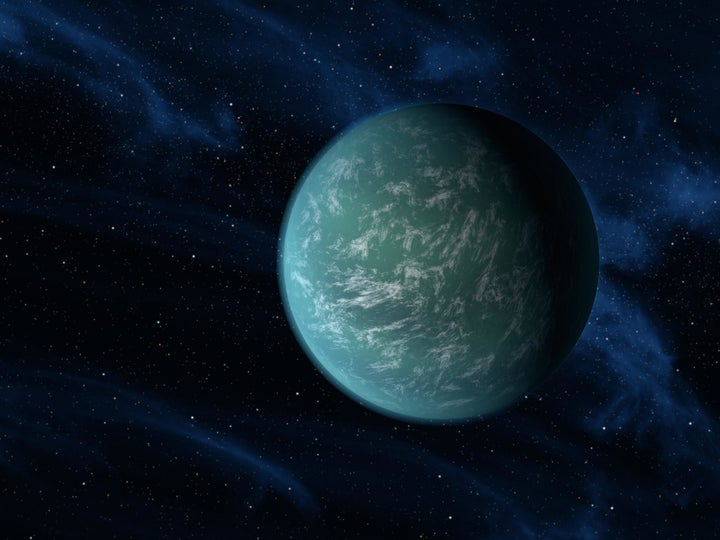
And what rough beast, its hour come round at last,
Slouches towards Bethlehem to be born?-- William Butler Yeats, "Second Coming"
The last few years have been heady for planet hunters. First the hot Jupiters; then the will-o'-the-wisp Glieslings and their cousins; and in the last year, the results from the Kepler mission, which detected planetary systems in the low thousands; one of these is Kepler-22b.
For anyone who was in a sequestered jury room or silently running nuclear submarine, Kepler-22b is a G5 type star (our sun is G2, about 10% bigger and hotter) 600 light years away with a planetary entourage. What got splashed across the news media yesterday was the confirmation that one of the Keplerings is a super-Earth (2.4 times the radius of our planet) that is solidly within the habitable zone of its primary - habitable defined as the region where water can remain liquid. It circles its primary in 289 days and its estimated average temperature is a balmy 22 C/75 F if (big if) it has an atmosphere thick enough for a mild greenhouse effect.
That's what we know, and it's important and exciting enough. Here's what we don't know, which makes the exclamations of "Twin Earth!" annoying: we don't know its mass (though the wobble velocity puts an upper limit of 36 Earth masses on it), its composition, the composition of its atmosphere or if it has any moons. Equally annoying are the suggestions to name it The Christmas Planet or the barely less mawkish Hope, right down there with the naming of putative Gliese 581g something like Betty (not even Elizabeth, which at least would celebrate an unforgettable historic figure, plus several literary ones).
The Kepler findings are pinning down of the still-loose middle terms of the Drake equation by strongly indicating that most suns have planetary systems, and most planets are of the small rocky variety. Of the approximately 2,000 systems Kepler tentatively identified, about fifty have planets within the habitable zone, of which about ten are "Earth-like" (loosely defined).
Half a percent may not sound too much. But given the quarter trillion suns in our galaxy, the numbers mount up quickly. Plus, of course, the size and location of the newcomer inevitably raises expectations: if Kepler-22b is rocky and has decent amounts of water and a reasonably thick atmosphere, the probability of life moves into the "likely" zone. So it's not surprising that the Allen Array turned its dishes in the direction of Kepler-22b (no requests for Warren Zevon yet, but the night is still young) -- or that the concept art is coming in thick and fast.
It is a great pity that Kepler-22b is so far. Even expeditions with quasi-exotic propulsion systems (or exceptionally nice humans in arkships) would take a long time to reach it. But the lengthening list of not-quite-Earths is a powerful enticement not to abandon the faltering beacon of space exploration. Once again, I will close with what I said about Gliese 581g:
Whether [Kepler-22b] is so hospitable that we could live there or so hostile that we could only visit it vicariously through robotic orbiters and rovers, if it harbors life -- even bacterial life, often mistakenly labeled "simple" -- the impact of such a discovery will exceed that of most other discoveries combined. Unless supremely advanced Kardashev III level aliens seeded the galaxy like the Hainish in Ursula Le Guin's Ekumen, this life will be an independent genesis, enabling biologists to define which requirements for life are universal and which are parochial.
At this point, we cannot determine if [Kepler-22b] has an atmosphere, let alone life signatures. If it has non-technological life, without a doubt it will be so different that we may not recognize it. Nor is it a given, despite our fond dreaming in science fiction, that we will be able to communicate with it if it is sentient. In practical terms, a second life sample may exist much closer to home -- on Mars, Europa, Titan or Enceladus. But those who are enthusiastic about this discovery articulate something beyond its potential seismic impact on biology and culture: the desire of humanity for companions among the sea of stars, a potent myth and an equally potent engine for exploration.
Note: As usual, this article is also posted on the author's site, with some nifty images!